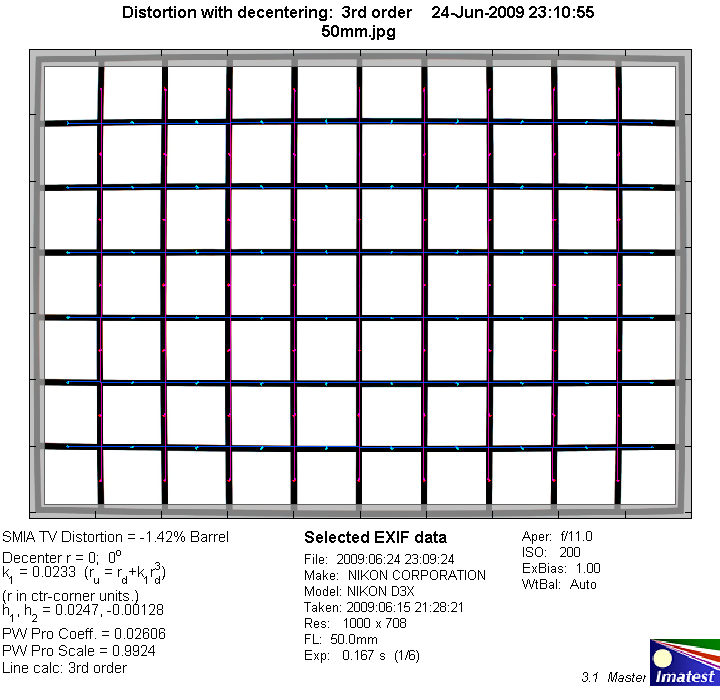|
Page 2 of 3

Distortion
The lens shows moderate barrel distortion at around 1.4%. This is more than you'd expect from a fix focal lens. However, this is actually a typical amount of distortion for fast standard primes and unless you shoot subjects with straight lines near the image borders it's usually not field relevant.

The chart above has a real-world size of about 120x80cm.
Vignetting
Fast lenses tend to suffer from high vignetting on full frame cameras and the AF-S 50 is no exception to this rule. At almost 2 EV the corners darken visibly wide open. There's a moderate level of vignetting left at f/2.0 which is reduced further to a negligible degree stopped down to f/2.8 and beyond.
We're performing our vignetting analysis based on
(uncorrected) JPEGs straight from the camera. The JPG engine of the Nikon D3x features a rather flat
gradation curve, thus has a moderate contrast characteristic, resulting in comparatively low vignetting figures - the
corresponding Canon figures are roughly 40% higher due to the more
aggressive default contrast setting.

MTF (resolution)
Standard primes have a reputation of delivering sharp images and the AF-S 50 does not disappoint in this regard.
(revised) In the center the resolution is very good wide open already, reaching excellent figures at f/2.8. The borders and extreme corners start a little softer wide open (where the lens also lacks some contrast), but also improve by stopping down, reaching very good levels at f/2.0 already and even excellent sharpness at f/5.6.
The lens showed some focus shift when stopping down (residual spherical aberration).
Please note that the MTF results are not directly comparable across the different systems!
Below is a simplified summary of the formal findings. The chart shows line widths
per picture height (LW/PH) which can be taken as a measure for sharpness.
If you want to know more about the MTF50 figures you may check out the corresponding
Imatest Explanations

Chromatic Aberrations (CAs)
(revised) Chromatic aberrations (color shadows at harsh contrast transitions) are in the range of roughly 0.9 to 1.3 pixels throughout the aperture range. Given the huge resolution of the test camera, this might be visible in very large prints (or heavy crops), however, for typical print sizes the problem isn't really field relevant for most subjects. In addition, CAs can easily be corrected in software or by the camera itself.

Bokeh
The quality of the bokeh (out-of-focus blur) is a primary aspect for such a large aperture lens. Unfortunately at wide open aperture the AF-S 50 shows a rather high amount of outlining resulting in a slightly nervous bokeh. From f/2 onwards these outlines disappear and the bokeh smoothens considerably, however highlights in the background remain troubled by LoCAs (see next section).
Thanks to 9 rounded aperture blades, background highlights remain their circular shape throughout the whole aperture range.

Bokeh Fringing / Longitudinal Chromatic Aberrations (LoCA)
LoCAs (non-coinciding focal planes of the various colors) are a common issue with relatively fast glass. As you can
notice below the halos have different colors - magenta (red + blue) in front the focus point
and green beyond. Truly "apochromatic" lenses don't show LoCAs but these lenses are very rare especially
below 100mm. Unlike lateral lateral CAs, LoCAs cannot easily be fixed in post processing.
Typical for most fast primes the AF-S 50 shows a considerable amount of LoCAs at large aperture settings.
In addition, these shots also show the focus shift when stopping down and demonstrate the lack of contrast and sharpness wide open (the latter being emphasized on short subject distances).
|